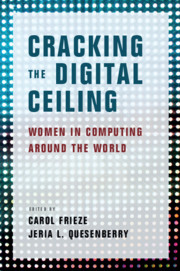Book contents
- Cracking the Digital Ceiling
- Cracking the Digital Ceiling
- Copyright page
- Contents
- Contributors
- Acknowledgments
- Introduction
- Part I Global Perspectives
- Part II Regional Perspectives
- Part III Cultural Perspectives from the United States and Europe
- Part IV Cultural Perspectives from Asia-Pacific
- Conclusion
- Notes
- Index
- References
Conclusion
Published online by Cambridge University Press: 10 October 2019
- Cracking the Digital Ceiling
- Cracking the Digital Ceiling
- Copyright page
- Contents
- Contributors
- Acknowledgments
- Introduction
- Part I Global Perspectives
- Part II Regional Perspectives
- Part III Cultural Perspectives from the United States and Europe
- Part IV Cultural Perspectives from Asia-Pacific
- Conclusion
- Notes
- Index
- References
Summary
As we close this collection of many perspectives from multiple cultures and countries we hope to have shown that women’s participation in computing is largely determined by cultural factors. We hope this book has provided a convincing argument that alternative ways of thinking about, and acting on, gender and computing issues could benefit both the field and the people in it. We have argued for the examination of variables outside a gender dichotomy as possible sources of differences in women’s participation in computing. In particular, we have suggested and illustrated that a cultural approach, an approach that pays close attention to culture and environment, focuses on the many factors that can allow for, or hinder, women’s participation.
- Type
- Chapter
- Information
- Cracking the Digital CeilingWomen in Computing around the World, pp. 324 - 336Publisher: Cambridge University PressPrint publication year: 2019

